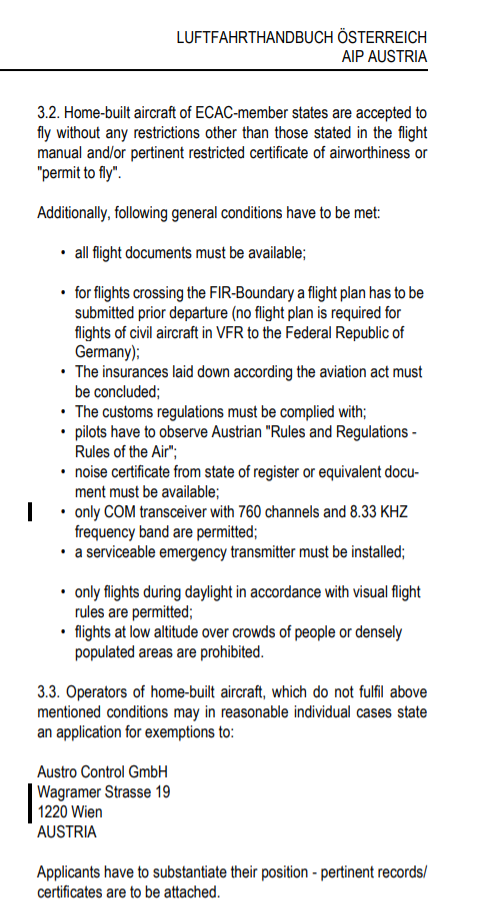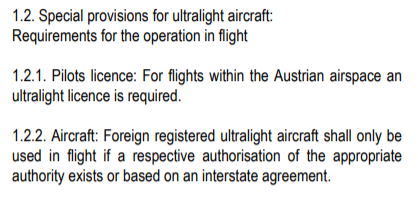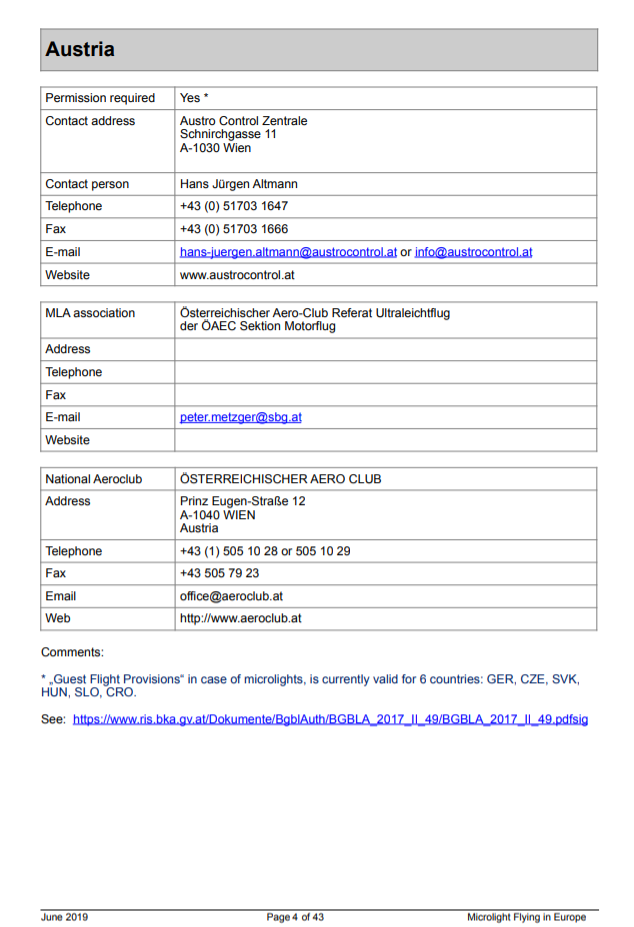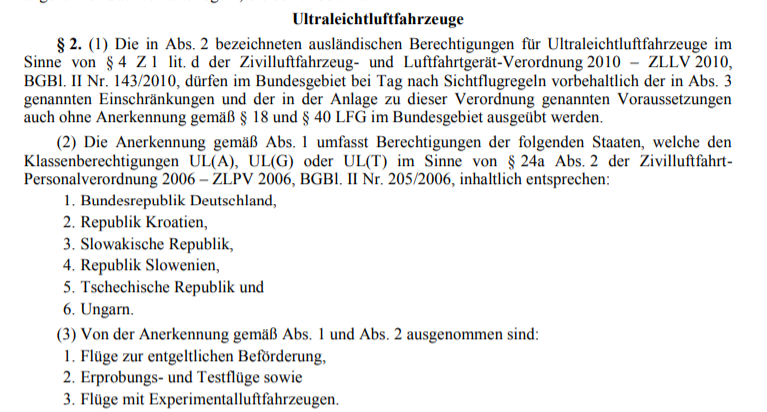Peter wrote:
But even the AIP is not the primary legislation.
This! It’s „info“, but not legally binding.
Yes, although IMHO you could never get prosecuted in any country with a decent justice system if you followed the AIP – because the State has a duty to publish accurate data. This principle does not work everywhere in Europe, however, and may require expensive representation.
LeSving wrote:
With these things, if you feel unsure (for some odd reason, don’t “want” to read AIP/NOTAM, don’t “believe” it, or whatever), then ask the appropriate authority directly. It is a mystery to me how people think that a board like this will give a definitive answer.
This is exactly what I did, LeSving, (I read the AIP, then contacted Austro Control) and after 2 weeks guess what. It got me an email which I cannot deceiver, and an attachment (a legal document in German) which is worse. May be I missed something, who knows. But I think the comments above are useful. So why this jibe at all about mysteries ? I don’t see the benefit.
Snoopy wrote:
I would be very interested to get a definitive answer. I might get in touch with Austrocontrol.
Apparently there are endless use cases, like … plane from here, built like this, self-declared or not, license issued here, added PPL, and so on. But if you could clarify the basics (any UL and same country license, any Annex I and PPL) in a comprehensible way, that would be useful. And if you could add any differences between over-flight, landing, landing at an Austrian controlled airport, that would be great.
Peter wrote:
Not everyone likes this stuff to be posted openly, but then I bump into a friend who has just paid out ~100k on one of these types and is quite shocked that he can’t just fly it all over Europe like “all the forums” told him so.
Which “all forums” ? Doesn’t matter, it proves my point just the same. First, this isn’t rocket science. Second, if you somehow are in doubt, then ask where you can get an answer. The CAA is a good starting point. Other good starting point are one of the local homebuilt/UL organisations or similar pilot organisation.
AJ wrote:
This is exactly what I did, LeSving, (I read the AIP, then contacted Austro Control) and after 2 weeks guess what. It got me an email which I cannot deceiver, and an attachment (a legal document in German) which is worse.
OK, my bad  But, it’s not clear at all what you are asking. Is it UL? Is it an experimental homebuilt? Is it a certified vintage, or an experimental registered vintage? Where is it registered? Where are you flying from? Just saying Annex II or non-EASA doesn’t help much. (It’s Annex I today by the way). It’s also not helping that you don’t understand the language, and don’t want/cannot ? post the reply here ?
But, it’s not clear at all what you are asking. Is it UL? Is it an experimental homebuilt? Is it a certified vintage, or an experimental registered vintage? Where is it registered? Where are you flying from? Just saying Annex II or non-EASA doesn’t help much. (It’s Annex I today by the way). It’s also not helping that you don’t understand the language, and don’t want/cannot ? post the reply here ?
Experimental homebuilt (straight from the AIP)

For microlight (straight from AIP)

From EMF:

This has a contact, telephone, e-mail, internet, street address etc to the Österrichsischer Aero Club, and also a direct link to the regulation:

Which, according to my poor German means the same as what the page at EMF say. If you have a license and an aircraft from one of those mentioned countries, you can fly in Austria without further permission.
Othervise? (or no matter what?) you have to follow what is written on page 4. Valid medical certificate or valid EASA medical etc. I’m sure some German speakers can translate that document properly.
I would have contacted the Austrian Aero Club.
In that case, why did @ploucandco have to pay €113+VAT? Was his plane non ECAC registered?
We need to see the text which @AJ saw.
Correct @lesving
Para 18 regulates the plane (UL) and Para 40 the license.
Para 18 is called “guest flight regulation”. It has the following annex (conditions to be met):
Anlage
Mindestanforderungen für den Betrieb ausländisch registrierter Ultraleichtluftfahrzeuge im Österreichischen Bundesgebiet
Register/Kennzeichnung
Eintragungsschein oder gleichwertig, der Halter muss ersichtlich sein (Haftungsgründe)
Kennzeichen am Rumpf mindestens 5 cm hoch
Datenschild mit Type und Kennzeichen
Lufttüchtigkeit und Aufrechterhaltung der Lufttüchtigkeit
Lufttüchtigkeitszeugnis oder gleichwertig (Permit to Fly)
System und Nachweis einer periodischen Prüfung zur Aufrechterhaltung der Lufttüchtigkeit (insbesondere Annual Inspection und Nachprüfbescheinigung)
Flug und/oder Betriebshandbuch
Nachweis der letzten Instandhaltung
Umweltanforderungen (Lärm)
Nachweis (z. B. Lärmzeugnis oder Lärmmessbericht) eines Lärmwertes geringer als 70dBA für Startfall (2,5 km vom Abflugpunkt)
Lizenzierung (Pilotenschein, Tauglichkeitszeugnis)
Pilotenschein/Lizenz des Staates, in dessen Register das Luftfahrzeug eingetragen ist (Registerstaat)
Gültiges flugmedizinisches Tauglichkeitszeugnis des Registerstaates oder ein flugmedizinisches Tauglichkeitszeugnis gemäß den Bestimmungen der Verordnung (EU) Nr. 1178/2011.
Flugbetrieb (NCO National)
Sämtliche anzuwendenden österreichischen Betriebsregeln einschließlich der LVR 2014 sind zu beachten sowie Maßnahmen der Flugvorbereitung (Wetter, NOTAM, Flugplanung, Vorflugkontrolle, Mindestkraftstoffmenge 30 min Reserve, Mindestflughöhen usw.) und Einholung gegebenenfalls erforderlicher weiterer Bewilligungen (zum Beispiel Außenlandungen und Abflüge).
Bordbuch oder gleichwertig (Flight Log)
Gewichts und Schwerpunktlage
Mindestausrüstung: Fahrtmesser, Höhenmesser, Kompass,
Periodische Prüfung der elektronischen Bordausrüstung inclusive der Pitot Static Systeme nach LTH 40 oder gleichwertig.
ELT oder PLB
Kontrollierte Lufträume
Sämtliche in österreichischen Regelungen enthaltene Anforderungen an den Betrieb von Luftfahrzeugen in kontrollierten Lufträumen insbesondere im Hinblick auf die Ausrüstung des Luftfahrzeugs sind zu beachten.
Versicherung
Haftpflichtversicherung entsprechend § 164 LFG beziehungsweise Verordnung (EG) Nr. 785/2004
Fernmeldebehördliche Bewilligung
Bewilligung der Funkanlagen entsprechend den Regelungen des Registerstaates.
Luftfahrtrechtliches Aufsichtssystem
Eine zuständige Behörde oder gleichwertige ermächtigte Organisation des Registerstaates muss vorhanden sein und in luftfahrtüblicher Weise (AIP) veröffentlicht sein. Im Anlassfall muss es der in Österreich zuständigen Behörde möglich sein, sicherheitsrelevante Informationen über den Betrieb in Österreich auszutauschen.
Grundbedingungen und Grenzen auf deren Basis die Mindestanforderungen erstellt wurden
Alle Auflagen und Betriebseinschränkungen der Betriebsregelungen des Registerstaates gelten auch beim Betrieb im österreichischen Luftraum.
English Translation
investment
Minimum requirements for the operation of foreign-registered ultralight aircraft in Austrian territory
Register / Labeling
Registration certificate or equivalent, the holder must be visible (liability reasons)
License plate on the hull at least 5 cm high
Data plate with type and number plate
Airworthiness and Continued Airworthiness
Certificate of Airworthiness or equivalent (Permit to Fly)
System and proof of a periodic airworthiness review (in particular Annual Inspection and Inspection Certificate)
Flight and / or Operations Manual
Proof of the last maintenance
Environmental requirements (noise)
Proof (eg noise certificate or noise measurement report) of a noise value lower than 70dBA for take-off (2.5 km from the departure point)
Licensing (pilot license, medical certificate)
Pilot license / license of the state in whose register the aircraft is registered (register state)
Valid medical certificate of medical fitness of the Registrar State or a medical certificate in accordance with the provisions of Regulation (EU) No 1178/2011.
Flight Operations (NCO National)
All applicable Austrian operating rules including the LVR 2014 are to be observed as well as measures of flight preparation (weather, NOTAM, flight planning, pre-flight check, minimum fuel reserve 30 min reserve, minimum flight altitudes, etc.) and collection of any required additional permits (for example, external landings and departures).
Logbook or equivalent (Flight Log)
Weight and balance
Minimum equipment: airspeed indicator, altimeter, compass,
Periodic testing of electronic on-board equipment including Pitot Static systems according to LTH 40 or equivalent.
ELT or PLB
Controlled airspaces
All requirements in Austrian regulations for the operation of aircraft in controlled airspaces, in particular with regard to the equipment of the aircraft, must be observed.
insurance
Liability insurance in accordance with § 164 LFG or Regulation (EC) No. 785/2004
Telecommunications Authorization
Authorization of the radio equipment in accordance with the regulations of the registering state.
Aviation regulatory system
A competent authority or equivalent authorized organization of the State of registry must be in place and published in the usual way (AIP). In case of need, the competent authority in Austria must be able to exchange safety-relevant information about the operation in Austria.
Basic conditions and limits on the basis of which the minimum requirements have been established
All conditions and operational restrictions of the operating regulations of the State of Registry also apply to operations in Austrian airspace.
Because Austrocontrol charges a fee for applying Para 18 (or any other paperwork, if for instance N-reg experimental): Here is the form: https://www.austrocontrol.at/jart/prj3/ac/data/dokumente/29nvP_FO_LFA_ACE_301_DE.pdf local copy
Translation of
https://www.austrocontrol.at/luftfahrtbehoerde/lizenzen_bewilligungen/flugbewilligungen/einflug_ueberflug
starts here:
Entry clearance for the Austrian airspace for aircraft with a reduced certificate of airworthiness
Foreign registered aircraft with restricted registration generally require a permit in accordance with § 18 LFG for entry and operation in Austria.
An application in this regard must be submitted by the holder to Austro Control.
The application should be submitted no later than five full business days before the intended flight begins.
exceptions:
Aircraft registered in an EU country with a reduced certificate of airworthiness issued in accordance with Regulation (EU) No 748/2012, Subpart H, which comply with ICAO Annex 8, do not require an entry clearance.
For ultralight aircraft, the regulations listed in ÖNfL I-B62 / 2001 must be applied.
The application must be accompanied by the following details or proof in German or English:
Purpose of the in / over flight
Requested period of grant
Registration certificate of the State of registry
Limited Certificate of Airworthiness, Permit to Fly or equivalent, including restrictions and restrictions
Proof of the timely execution of the required maintenance work or annual inspection (valid inspection certificate, inspection report)
Noise certificate, proof of soundness or noise exemption approval
Compulsory insurance in accordance with §§ 164 ff LFG or according to Regulation (EC) No. 785/2004
After examining the application, additional documents / proofs can be requested. The granting of the license is subject to a fee.
My plane is N registered, outside of the ECAC constellation!
In many countries (Germany, Poland, Czech, Sweden, Romania, Bulgaria, Ukraine), you get a permit for free. In others, it costs between 30EUR (France) to around 100-130EUR (Belgium, Switzerland, Austria). Then, there is Denmark… that was 300EUR about 11 years ago, still at this level, I recently heard. Typically you can get an annual permit except France and Austria. Getting a permit was never an issue, a website form, an e-mail or a fax and some days later, you get it.
Regarding “exception” above, this is the EU Reg 748 Subpart H for “restricted certificate of airworthiness “:
21.B.327 Restricted certificate of airworthiness
(a)
The competent authority of the Member State of registry shall issue a restricted certificate of airworthiness for:
1.
new aircraft:
(i)
upon presentation of the documentation required by point 21.A.174(b)(2);
(ii)
when the competent authority of the Member State of registry is satisfied that the aircraft conforms to a design approved by the Agency under a restricted type-certificate or in accordance with specific airworthiness specifications, and is in a condition for safe operation. This may include inspections by the competent authority of the Member State of registry;
2.
used aircraft:
(i)
upon presentation of the documentation required by point 21.A.174(b)(3) demonstrating that:
(A)
the aircraft conforms to a design approved by the Agency under a restricted type-certificate or in accordance with specific airworthiness specifications and any supplemental type-certificate change or repair approved in accordance with this Annex I (Part 21); and
(B)
the applicable airworthiness directives have been complied with; and
(C)
the aircraft has been inspected in accordance with the applicable provisions of Annex I (Part M) of [Regulation (EC) No 2042/2003];
(ii)
when the competent authority of the Member State of registry is satisfied that the aircraft conforms to the approved design and is in a condition for safe operation. This may include inspections by the competent authority of the Member State of registry.
(b)
For an aircraft that cannot comply with the essential requirements referred to in Regulation (EC) No 216/2008 and which is not eligible for a restricted type-certificate, the Agency shall, as necessary to take account of deviations from these essential requirements:
1.
issue and check compliance with specific airworthiness specifications ensuring adequate safety with regard to the intended use, and
2.
specify limitations for use of this aircraft.
(c)
Limitations for use will be associated with restricted certificates of airworthiness, including airspace restrictions, as necessary to take account of deviations from essential requirements for airworthiness laid down in Regulation (EC) No 216/2008.
Can anyone answer me:
1) Is an experimental (restricted cofa?) bound by EU law or national law?
2) I understand ECAC is a “non binding” sort of treaty about private non commercial flights?
3) The exception of Para 18 would mean that a EASA registered experimental can fly freely in Austria, correct?